Murder on the Mississippi (Activision) - 1986
This review is part of the “Let’s Adventure!” series. See all reviewed games sorted by rating here.
Murder on the Mississippi is a 1986 detective adventure game developed and published by Activision for the Commodore 64, Commodore 128 and the Apple II computers, where you assume the role of Sir Charles Foxworth and must solve a murder mystery on the luxury ship “Delta Princess”. The story is based loosely on the Agatha Christie novel Death on the Nile.
When playing these earlier PC games it’s important to call out what they did right, and where they may have been innovative. This game starts off with some theme music and an animated introduction, the sets the stage for our character’s journey. Once you’re in your cabin and gain control of Sir Charles, you have an opportunity to move around and get acquainted with the controls.
You leave your cabin and start walking around, testing doors and learning how to navigate the ship. Eventually you’ll make your way from cabin #3 (your home cabin) to the other side of the ship and cabin #4. Once inside you discover a murder has taken place and it’s crime solving time.
Unlike most verb-based adventure games, Murder on the Mississippi offers you only a handful of options on every screen. These options will change depending on whether there’s an NPC on screen or not, but ultimately you can always WALK AROUND, INSPECT or EXAMINE EVIDENCE. Inspecting the environment is contextual, so you need to be “near” something that you can interact with (such as a table, cabinet, etc).
If you’re lucky, there may be a clue hidden in, around, behind or under whatever you happen to be inspecting.
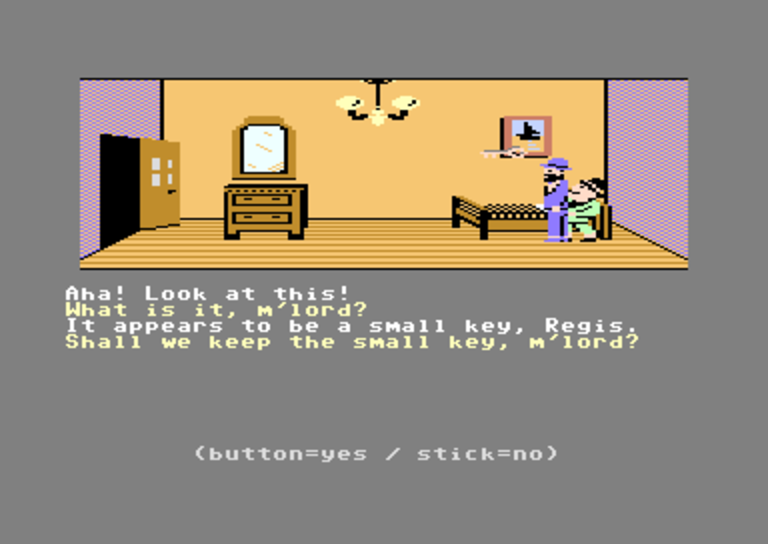 Well look at that, there was a key under the pillow!
Well look at that, there was a key under the pillow!
The ship contains 28 locations you can investigate (27 cabins and the wheelhouse where the captain is). Though this may seem like a lot, there are really only a handful of cabins that contain anything notable, and the cast of characters you can interact with is actually pretty small.
Since this is a murder mystery, interacting with characters to piece together their stories is a big part of the game. I found the approach they took here to be pretty clever, though it may not have been intuitive.
Every character you meet gives you the option to ask them about either (a) the victim, or (b) any other character you’ve already met. For each of these interactions you’re able to “take notes”, which involves moving the cursor over each word in their response and forming a sentence you may want to use when speaking to other characters.
This mechanic is clever, but actually extremely hard to get right. The thing is, you can ask characters about the victim as many times as you want, but you can only ask them about other characters once. If you forget to take notes, or you take the wrong note - you’re fucked.
As you collect these notes, you can share them with other characters. This is how you advance the plot - assuming you wrote the write thing down in the first place. Incorrect notes give you a generic response, which sucks because you have no idea that you’re on the right track but asked the wrong thing.
I used a walkthrough for this portion so I’m not sure if it would have worked to just copy the entire response as the note (like copy literally everything every character said).
As you find clues you’ll periodically have to go back to your cabin to stow them in the steamer trunk. This is both because your sidekick (Regis) can only carry so many items. Within the steamer trunk you’re able to examine individual items, or combine them by placing two items on the examination table and selecting EXAMINE.
There are a number of clues you can combine, and I’d highly recommend you examine everything (and all combinations) more than once. For example, once you unlock the rosewood box with the key and find what’s inside, examining it a second time reveals a false bottom with more clues in it.
When you’re finally satisfied that you’ve solved the murder, the last thing to do is go to the character’s cabin you think is guilty and accuse them. This results in the characters being gathered together, a long exchange between all of them and Sir Charles and hopefully a confession from the killer.
Overall I found this game to be pretty well paced and engaging. There are a couple places where you can die because the killer has set traps that you’ll need to avoid and these will catch you by surprise the first time - so save A LOT. Similarly every time I wanted to ask a character about what another character was saying I’d save before taking notes in case what I noted ended up not getting a response.
The note taking/sharing was interesting but ultimately frustrating as it’s so easy to get wrong. Thankfully there weren’t too many combinations you of note and characters, and it became increasingly easy to determine when characters weren’t sharing anything noteworthy (so you could skip taking notes on those responses).
 If all goes well you make it to New Orleans
If all goes well you make it to New Orleans
I didn’t think I was going to like this game, but in the end I really did. The music is pretty simple - but it’s there. Every character has their own tune that plays when you enter their cabin, there’s background music as you walk around the ship and you get occasional sound effects as you bump into things as you investigate.
Murder on the Mississippi is not a great game, but I had a good time working through the mystery and eventually finding the killer. Though you literally have to investigate EVERYTHING to try and surface clues where there’s no indication anything might exist, the game is still pretty short and can be enjoyable (unless you’re this Japanese gamer that spent 2 years making a strategy guide to clear the game).
Game Information
| Game | Murder on the Mississippi |
| Developer | Activision |
| Publisher | Activision |
| Release Date | 1986 |
| Systems | Apple II, Commodore 64/128, MSX2, Atari 800/XE/XL |
| Game Engine |
My Playthrough
| How Long To Beat? | 4 hours |
| Version Played | Commodore 64 via VICE |
| Notes | Walkthrough |
Score
See here for a refresher on how we’re scoring these games.
| Atmosphere (20) | 7 |
| Story (25) | 9 |
| Experience (15) | 5 |
| Impact (10) | 3 |
| 34% |
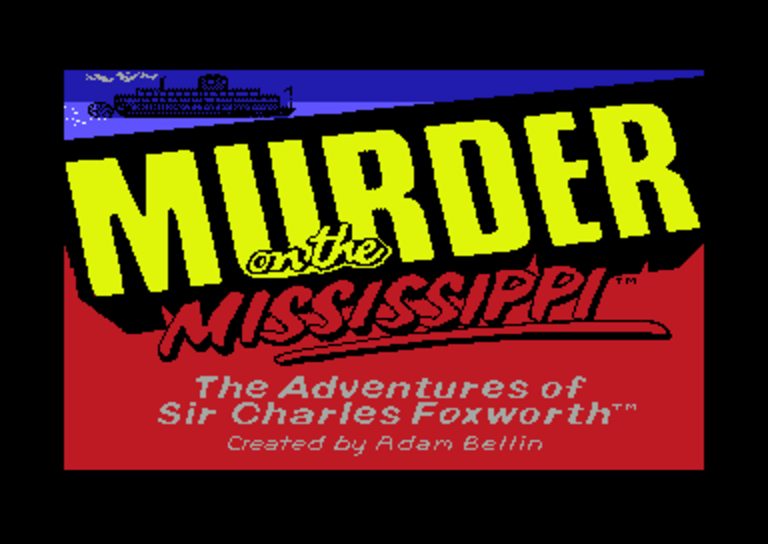
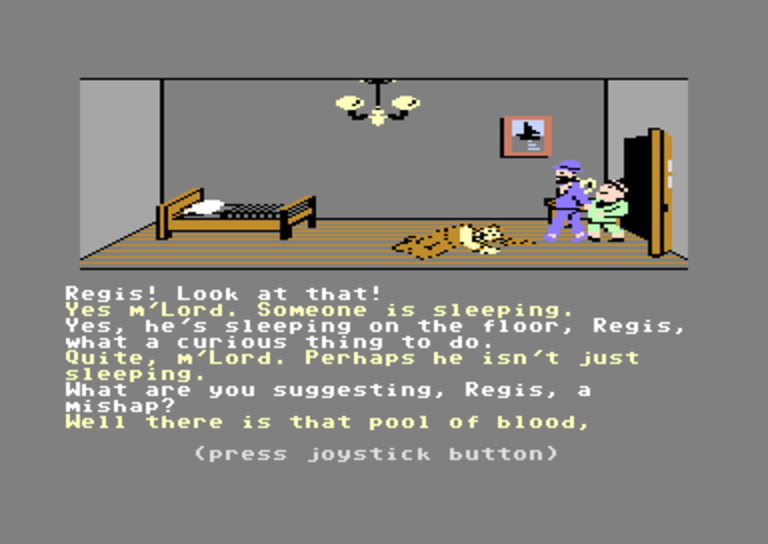

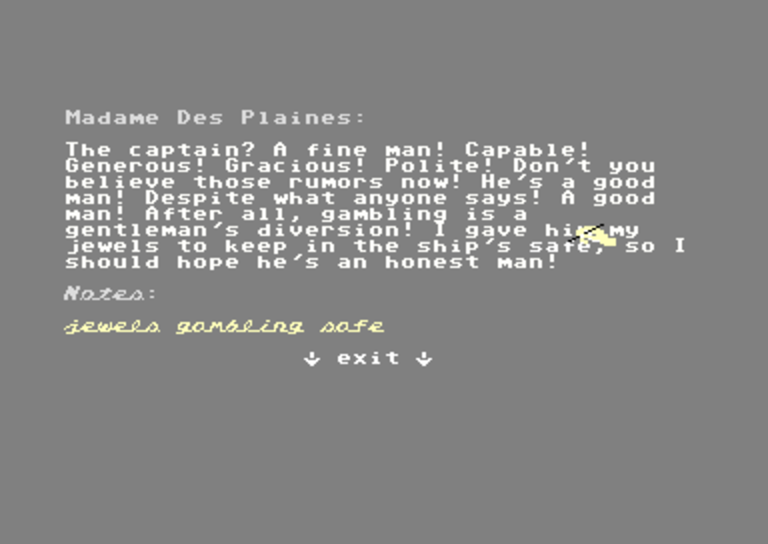
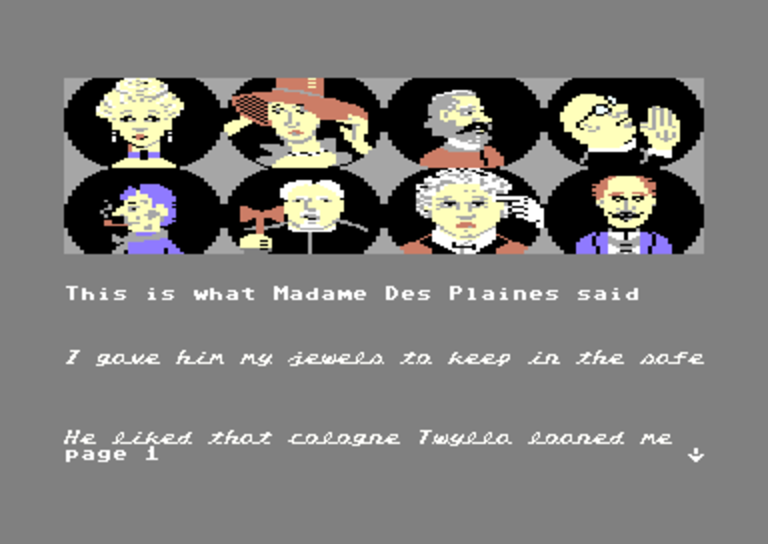
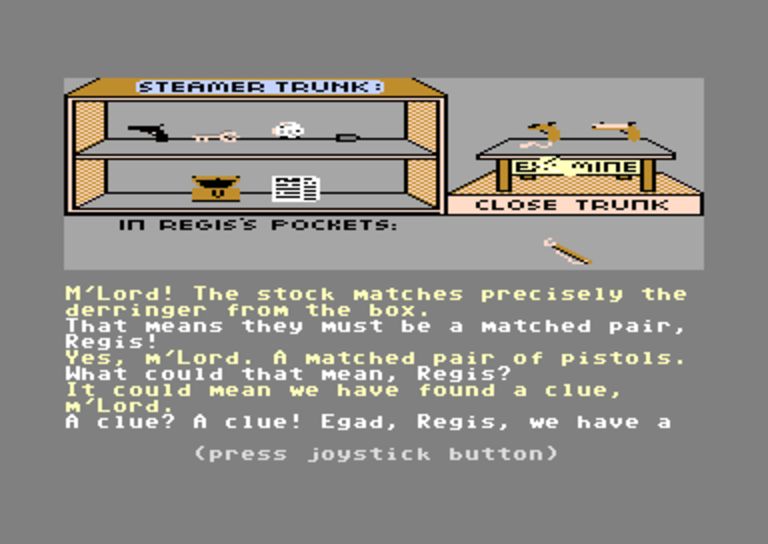
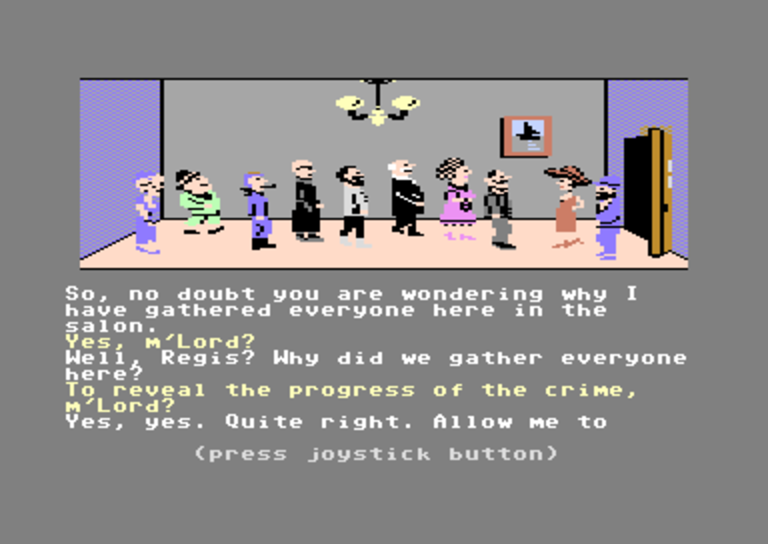
Comments powered by Disqus.